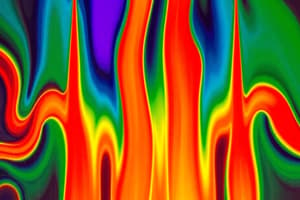Podcast
Questions and Answers
What is the unit of measurement for heat capacity?
What is the unit of measurement for heat capacity?
- J/g°C (correct)
- J/°C (correct)
- cal/°C (correct)
- cal/g°C (correct)
Which type of heat transfer occurs through the movement of fluids?
Which type of heat transfer occurs through the movement of fluids?
- Radiation
- Thermal Conduction
- Conduction
- Convection (correct)
What is the term for the amount of heat energy required to change the temperature of a system by 1°C?
What is the term for the amount of heat energy required to change the temperature of a system by 1°C?
- Thermal Conduction
- Heat Capacity (correct)
- Specific Heat
- Convective Heat Transfer
Which law of thermodynamics states that energy cannot be created or destroyed, only converted from one form to another?
Which law of thermodynamics states that energy cannot be created or destroyed, only converted from one form to another?
What is the term for the transfer of energy through electromagnetic waves?
What is the term for the transfer of energy through electromagnetic waves?
Which type of heat transfer occurs in solids, liquids, and gases?
Which type of heat transfer occurs in solids, liquids, and gases?
What is the unit of measurement for temperature?
What is the unit of measurement for temperature?
Which law of thermodynamics states that the total entropy of an isolated system always increases over time?
Which law of thermodynamics states that the total entropy of an isolated system always increases over time?
What is the term for the direct transfer of energy between particles in physical contact?
What is the term for the direct transfer of energy between particles in physical contact?
Flashcards are hidden until you start studying
Study Notes
Definition and Measurement
- Heat is a form of energy transferred from one body to another due to a temperature difference.
- It is measured in joules (J) or calories (cal).
- Temperature is a measure of the average kinetic energy of particles in a substance, measured in Celsius (°C), Fahrenheit (°F), or Kelvin (K).
Types of Heat Transfer
- Conduction: direct transfer of energy between particles in physical contact.
- Convection: transfer of energy through the movement of fluids.
- Radiation: transfer of energy through electromagnetic waves.
Heat Transfer Mechanisms
- Thermal Conduction:
- Occurs in solids, liquids, and gases.
- Rate of conduction depends on temperature difference, material properties, and surface area.
- Convective Heat Transfer:
- Occurs in fluids (liquids and gases).
- Depends on fluid motion, temperature difference, and fluid properties.
- Radiative Heat Transfer:
- Occurs in all media (solids, liquids, and gases).
- Depends on temperature difference, surface emissivity, and surrounding environment.
Heat Capacity and Specific Heat
- Heat Capacity: amount of heat energy required to change the temperature of a system by 1°C.
- Specific Heat: heat capacity per unit mass of a substance, measured in J/g°C or cal/g°C.
Laws of Thermodynamics
- Zeroth Law of Thermodynamics: if two systems are in thermal equilibrium with a third system, they are also in thermal equilibrium with each other.
- First Law of Thermodynamics: energy cannot be created or destroyed, only converted from one form to another.
- Second Law of Thermodynamics: total entropy of an isolated system always increases over time.
Heat and Temperature
- Heat is a form of energy that is transferred between bodies due to a temperature difference.
- Heat is measured in joules (J) or calories (cal).
- Temperature is a measure of the average kinetic energy of particles in a substance.
Temperature Measurement
- Temperature can be measured in Celsius (°C), Fahrenheit (°F), or Kelvin (K).
Types of Heat Transfer
- Conduction: the direct transfer of energy between particles in physical contact.
- Convection: the transfer of energy through the movement of fluids.
- Radiation: the transfer of energy through electromagnetic waves.
Heat Transfer Mechanisms
Thermal Conduction
- Occurs in solids, liquids, and gases.
- Rate of conduction depends on:
- Temperature difference.
- Material properties.
- Surface area.
Convective Heat Transfer
- Occurs in fluids (liquids and gases).
- Depends on:
- Fluid motion.
- Temperature difference.
- Fluid properties.
Radiative Heat Transfer
- Occurs in all media (solids, liquids, and gases).
- Depends on:
- Temperature difference.
- Surface emissivity.
- Surrounding environment.
Heat Capacity and Specific Heat
- Heat capacity: the amount of heat energy required to change the temperature of a system by 1°C.
- Specific heat: heat capacity per unit mass of a substance, measured in J/g°C or cal/g°C.
Laws of Thermodynamics
Zeroth Law of Thermodynamics
- If two systems are in thermal equilibrium with a third system, they are also in thermal equilibrium with each other.
First Law of Thermodynamics
- Energy cannot be created or destroyed, only converted from one form to another.
Second Law of Thermodynamics
- Total entropy of an isolated system always increases over time.
Studying That Suits You
Use AI to generate personalized quizzes and flashcards to suit your learning preferences.



